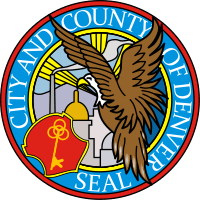Denver Museum of Nature and Science
The Denver Museum of Nature & Science is a municipal natural history and science museum in Denver, Colorado. It is a resource for informal science education in the Rocky Mountain region. A variety of exhibitions, programs, and activities help museum visitors learn about the natural history of Colorado, Earth, and the universe. The 716,000-square-foot (66,519 m2) building houses more than one million objects in its collections including natural history and anthropological materials, as well as archival and library resources.
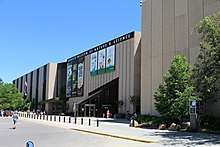 Denver Museum of Nature & Science | |
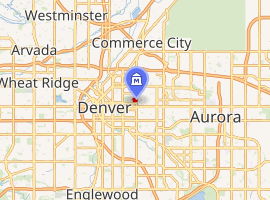
| |
| Established | December 6, 1900 (119 years ago) |
|---|---|
| Location | Denver, Colorado |
| Type | Natural History |
| Visitors | 1.9 million (2016)[1] |
| President | George Sparks |
| Website | www |
The museum is an independent, nonprofit institution with approximately 350 full-time and part-time staff, more than 1,800 volunteers, and a 25-member board of trustees. It is accredited by the American Alliance of Museums[2] and is a Smithsonian Institution affiliate.
Education programs
The museum provides programming in six main areas. The exhibitions, IMAX films, lectures, classes, and programs pertain to one or more of the following core competencies: anthropology, geology, health science, paleontology, space science, and zoology. More than 300,000 students and teachers visit the museum with school groups each year. In addition, the museum has science outreach programs and distance–learning opportunities for families, schools and surrounding communities. The museum also offers ongoing professional training workshops for teachers.
History
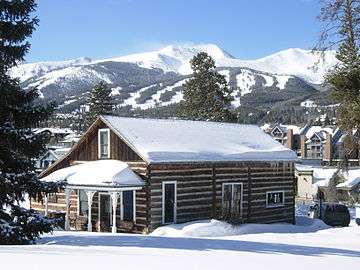
In 1868, Edwin Carter moved into a tiny cabin in Breckenridge, Colorado, to pursue his passion, the scientific study of the birds and mammals of the Rocky Mountains. Almost single-handedly, Carter assembled one of the most complete collections of Colorado fauna then in existence.[3]
Word of Carter's collection spread and, in 1892, a group of prominent Denver citizens declared their interest in moving his collection to the capital city for all to see. Carter offered to sell the entire collection for $10,000. The founders also secured a collection of butterflies and moths, and a collection of crystallized gold.[4]
Together, these three collections formed the nucleus of what would become the Colorado Museum of Natural History, officially incorporated on December 6, 1900. After years of preparation and construction, the Colorado Museum of Natural History finally opened to the public on July 1, 1908.[5] John Campion, the first president of the board, said in his dedication address, "A museum of natural history is never finished". The first director was hired and quickly recruited staff to build more exhibits and create public programs. By 1918, another wing had opened and research efforts were well underway.
In 1927, a team led by the Colorado Museum discovered two stone projectile points embedded in an extinct species of bison, in Folsom, New Mexico. These Folsom points demonstrated that humans had lived in North America more than 10,000 years ago, hundreds of years earlier than previously believed.[6]
The city of Denver increased its funding for the museum, leading to a name change to Denver Museum of Natural History in 1948.[7] The name was changed again in 2000 to the present Denver Museum of Nature and Science, reflecting the institution's wider focus.[8]
The museum is partially funded by the Scientific and Cultural Facilities District (SCFD), which was created by area voters in 1988.[9] It has also attracted large donations from benefactors, such as Morgridge Family Foundation led by philanthropist Carrie Morgridge, which gave $8 million to the museum in 2010, described as being the largest single gift since its founding.[10]
Permanent exhibits
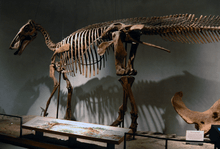
Prehistoric Journey
Prehistoric Journey traces the evolution of life on Earth. Displays include skeletons of Edmontosaurus, Maiasaura, Diplodocus, Gargoyleosaurus, Allosaurus, Stegosaurus and Othnielia, a sea lily reef diorama from 435 million years ago, a cast/replica skull of the ancient placoderm fish, Dunkleosteus, and a collection of trilobites.[11]
Egyptian Mummies
Egyptian Mummies contains two mummies, along with several coffins and other various antiquities. In both 1991 and 2016, the mummies were subjected to CT scans at Children's Hospital in Aurora, Colorado.[12][13]
Wildlife Halls
The Wildlife Halls are animal dioramas showing scenes of daily life of many different animals, one of the largest collections of its type in North America. The Wildlife Halls in the museum are:
Birds of the Americas
Explore Colorado (also known as Explore Colorado: From Plains to Peaks)
South America (also known as Sketches of South America)
Botswana, Africa (also known as Africa-Botswana: Sharing a Fragile Land and Botswana: Safari to Wild Africa)
| Species and locations represented in Botswana: Safari to Wild Africa | ||||||||||
|---|---|---|---|---|---|---|---|---|---|---|
| Botswana | Chacma baboon | Rufus-crowned roller | Greater kudu | Sable antelope | Warthog | Red-billed francolin | Steenbok | Plains zebra | ||
| Northern Botswana | Lion | Yellow-billed hornbill | ||||||||
| Botswana | Sitatunga | Malachite kingfisher | Nile crocodile | Hippopotamus | ||||||
| Dung beetle | Cheetah | Impala | ||||||||
| Southern Botswana | Gemsbok | Zebra white | African monarch | Brown-veined white | Lemon traveler | Banded gold tip | Broad-bordered grass yellow | African orange tip | Springbok | Red hartebeest |
| Northern Botswana | African fish eagle | Red lechwe | Waterbuck | |||||||
| Botswana | Bat-eared fox | African civet | African porcupine | Giant eagle owl | Ratel or honey badger | Spring hare | African wildcat | |||
| Leopard | Common duiker | |||||||||
| Aardwolf | Aardvark | Cape pangolin |
Northern and Rare Birds (also known as Birds of North America)
Edge of the Wild
Australia and South Pacific Islands (also known as Australia and South Pacific)
Bears and Sea Mammals (also known as Into the Wild: Bears and Sea Mammals and North American Bears and Northern Sea Mammals)
| Species and locations represented in Northern Sea Mammals | ||||
|---|---|---|---|---|
| Diomede Islands, Bering Strait | Walrus | Bearded seal | Ringed seal | Spotted seal |
| Pribilof Islands, Alaska | Northern fur seal | |||
| Monterey County, California | California sea lion | Steller sea lion | ||
| Alaska | Polar bear | Ribbon seal |
| Species and locations represented in North American Bears | |
|---|---|
| Aleutian Islands, Alaska | Brown bear |
| Yakutat, Alaska | Glacier bear |
| Gribbell Island, British Columbia | Spirit bear |
| Alaska | Barren ground grizzly |
| Archuleta County, Colorado | Grizzly bear |
| Yellowstone National Park, Wyoming | Black bear |
North American Wildlife (also known as Scenes of Change and North America's Wild Places)
| Species and locations represented in Scenes of Change | |||||||||
|---|---|---|---|---|---|---|---|---|---|
| Jackson County, Colorado | Beaver | ||||||||
| Elbert County, Colorado | Coyote | Darkling beetle | Edwards' fritillary | Orange sulphur | |||||
| Talkeetna Mountains, Alaska | Caribou | Arctic ground squirrel | Moose | ||||||
| Montague Island, Alaska | Sitka deer | American crow | Steller's jay | ||||||
| Porter's Creek, Great Smoky Mountains National Park, North Carolina and Tennessee | Black-and-white warbler | Scarlet tanager | Eastern chipmunk | Ovenbird | Black-throated blue warbler | Dark-eyed junco | Red squirrel | Striped skunk | White-eyed vireo |
| Great Smoky Mountains National Park, North Carolina and Tennessee | Southern flying squirrel | Whip-poor-will | Hairy-tailed mole | Raccoon | Eastern screech-owl | ||||
| Hoh River, Olympic National Park, Washington | Douglas squirrel | Pacific banana slug | Yellow-spotted millipede | Lorquin's admiral | |||||
| Orient Mine, San Luis Valley, Colorado | Mexican free-tailed bat | ||||||||
| Citrus County, Florida | West Indian manatee | Pinfish | Striped mullet | Bluegill |
| Species and locations represented in North America's Wild Places | ||||
|---|---|---|---|---|
| Gates of the Arctic National Park and Preserve, Alaska | Canada lynx | |||
| Yellowstone National Park, Wyoming | American marten | Red squirrel | Golden-mantled ground squirrel | Clark's nutcracker |
| Kenai Fjords National Park, Alaska | Mountain goat | Gyrfalcon, largest of the falcons | ||
| Gates of the Arctic National Park and Preserve, Alaska | Gray wolf | |||
| Denali National Park, Alaska | Dall's sheep | |||
| Ellesmere Island | Muskox | Gray wolves (white variety called "Arctic") | ||
| Cassiar Mountains, British Columbia | Stone's sheep | Hoary marmot | ||
| Prudhoe Bay, Alaska | Caribou | Willow ptarmigan in winter-white plumage | ||
| San Miguel County, Colorado | American mink | Steller's jays | ||
| Denali National Park, Alaska | Wolverine |
Out of all of the dioramas in the museum listed here, only one, Western Brazil,[14] which depicted wildlife on the Brazilian savanna, was removed for not being scientifically accurate, because it included animals that didn't naturally interact with each other in the wild.[15] However, at least three pieces of evidence that prove that the diorama did exist can be found in the museum: one being a cropped image of the screenshot of the diorama's brocket deer from the museum's 1961 annual report in Edge of the Wild, and the other two being the scarlet macaw and blue-fronted parrot found in the glass case at South America's entry wall.
Space Odyssey
Space Odyssey is about the Universe and our place in it. One major highlight is a full-scale replica of a Mars Exploration Rover.
Expedition Health
Expedition Health teaches visitors about the human body, including the science of taste.[16]
Gems & Minerals
Gems & Minerals is a re-created mine where visitors can examine many colorful crystals and minerals found both locally and globally.
North American Indian Cultures
North American Indian Cultures explores the diversity among Native American groups and the practicality and artistry of their everyday objects.
Research and collections

- The Anthropology Collection contains over 50,000 objects and is made up of archaeological and ethnological artifacts from North America. The department also curates collections from Central and South America, Africa, Asia, and Oceania. Additional holdings include the 800-piece Ethnological Art Collection, and archival photographs and documents. The department is fully committed to compliance with the 1990 Native American Graves Protection and Repatriation Act (NAGPRA) and all other national and international laws that impact anthropological objects.
- Earth Sciences Collection consists of six main groups: vertebrate paleontology, paleobotany, invertebrate paleontology, minerals, meteorites, and micromount.
- Health Sciences Collection is composed of rare and unique human anatomy specimens, as well as a small selection of pieces of medical importance.
- Space Sciences Lab is responsible for the museum's Scientific Instruments Collection. This collection is composed of instruments that have been used by museum staff members or are excellent type-examples of particular instruments. In addition, the Department of Space Sciences maintains a large digital collection of images and multimedia assets (presentations, video, visualizations) of use in research, public programs, and Space Odyssey.
- Zoology Collection houses over 900,000 specimens or specimen lots (groups of specimens) including over 40,000 vials of arachnids (spiders and their relatives), over 780,000 insects, especially the orders Coleoptera (the beetles) and Lepidoptera (the butterflies and moths), 17,000 shell lots representing shells from all over the world, approximately 52,000 bird specimens, including a significant nest and egg collection, over 14,000 specimens of mammals, including several threatened or endangered species and several species now considered extinct. The small botany collection includes over 2,500 specimens representing 130 families. Specimens records are published, via Arctos[17] and Symbiota, to data portals such as SCAN, ORNIS,[18] MANIS,[19] VertNet,[20] GBIF,[21] GenBank,[22] and BISON.[23]
- Bailey Library and Archives focuses on anthropology, earth sciences, health sciences, space sciences, zoology, the Rocky Mountain West, and museum studies. It contains over 53,000 publications, 2,500 rare books, and 9,000 volumes of scientific periodicals.[24]
Selection of temporary exhibits
- Ancient Denver, a series of paintings by local artists that depict the Denver area from 300 million years ago to the present.[25]
- Maya: Hidden Worlds Revealed, a large exhibit covering art, culture, astronomy, religion, ball games and warfare, as well as potential reasons for the collapse of the Mayan empire.[26][27]
- Whales: Giants of the Deep, an exhibit that originated in New Zealand, where there was a large whale-fishing industry. The exhibit includes whale skulls and skeletons, videos, cultural artifacts, and "explaration stations".[28]
- Traveling the Silk Road, artifacts from the ancient trade route, from Xi’an, the imperial city of China's Tang Dynasty, to Istanbul.[29][30]
Gates Planetarium
Gates Planetarium is a 125-seat planetarium that features unidirectional, semi-reclining stadium seating, 16.4 surround-sound system featuring Ambisonic, a 3-D spatial sound system, and a perforated metal dome, 56 ft (17 m) in diameter and tilted 25 degrees. The current planetarium replaces an older, dome-style planetarium.[31]
Phipps IMAX Theater
The Phipps IMAX Theater on the second floor of the museum was built as the Phipps Auditorium in 1940, and was used for lectures, concerts, and films until 1980. Renovated and reopened in 1983 as the Phipps IMAX Theater, it seats 440 people and now shows large-format IMAX films daily.
Morgridge Family Exploration Center and Avenir Collections Facility
In 2014, a $70 million addition was added to the museum containing the Morgridge Family Exploration Center and the Avenir Collections Center.[32]
The Morgridge Family Exploration Center constitutes three above-ground levels that encourage visitors to learn about science and the natural world. The center includes Exploration Studios, a new temporary exhibition gallery, an atrium space, a completely-redeveloped Discovery Zone for early learners, and the outdoor, Boettcher Plaza with unique public art.
The Avenir Collections Center, part of a $70 million expansion in 2007, is a climate-controlled facility devoted to housing for nearly 1.5 million artifacts and specimens. The facility includes 63,000 square feet in two underground levels, and holds specimens such as bison from the 1870s, passenger pigeons, the last grizzly bear to be killed in Colorado in 1979, and roadkill brought in by the public. The data from these specimens is placed in online databases, and linked to public databases, like BioPortal.[33][34]
Museum secrets
The museum contains a number of hidden secrets that visitors may search for. On the Denver Museum website, there are four different downloadable scavenger hunts available, ranging from State Parks to "Museum Treasures".[35] Kent Pendleton, one of the museum's diorama painters, painted eight elves in his work, hidden throughout the museum. Guests are encouraged to search for the elves with one of the printable scavenger hunts.[36][37] In the IMAX lobby entrance there are several painted pictures hidden on the walls relating to Star Wars.[36][37]
Gallery
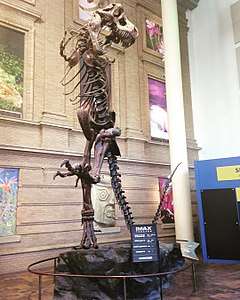 Tyrannosaurus rex skeleton located at the museum entrance
Tyrannosaurus rex skeleton located at the museum entrance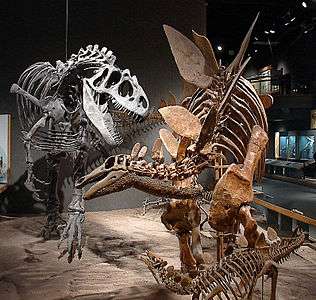 A Stegosaurus stenops and an Allosaurus fragilis from the Prehistoric Journey exhibit
A Stegosaurus stenops and an Allosaurus fragilis from the Prehistoric Journey exhibit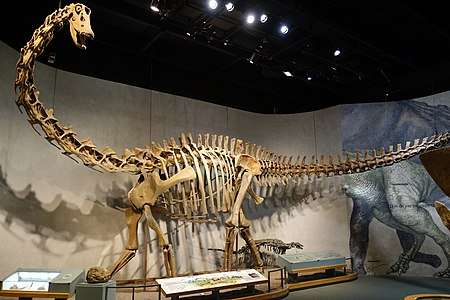 A Diplodocus longus
A Diplodocus longus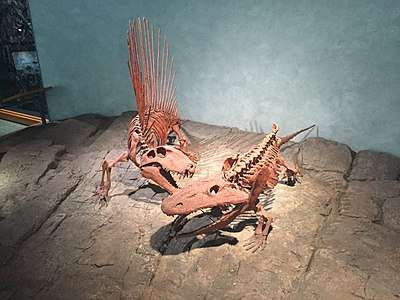 A Dimetrodon limbatus and an Eryops megacephalus
A Dimetrodon limbatus and an Eryops megacephalus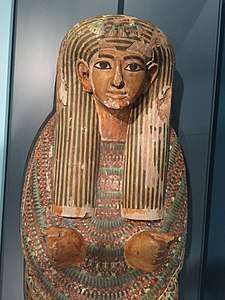 Coffin lid of Ankh-ef-en-Khonsu, a scribe at the Temple of Amun in Thebes
Coffin lid of Ankh-ef-en-Khonsu, a scribe at the Temple of Amun in Thebes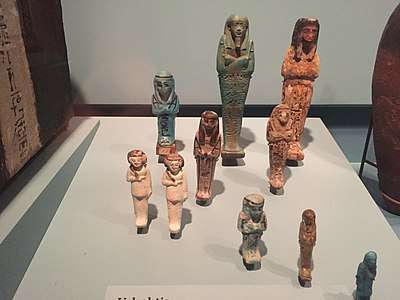 An assortment of Ushabti figurines
An assortment of Ushabti figurines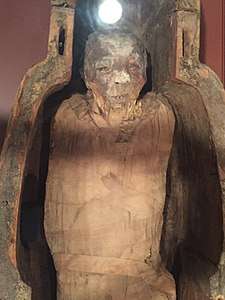 The so-called "Poor Woman's Mummy", from the Ptolomeic period.
The so-called "Poor Woman's Mummy", from the Ptolomeic period.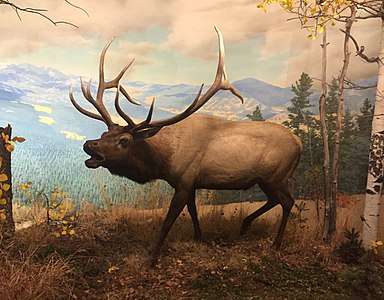 Wapiti Elk from a diorama
Wapiti Elk from a diorama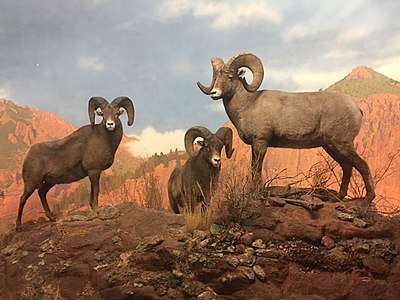 Bighorn sheep diorama
Bighorn sheep diorama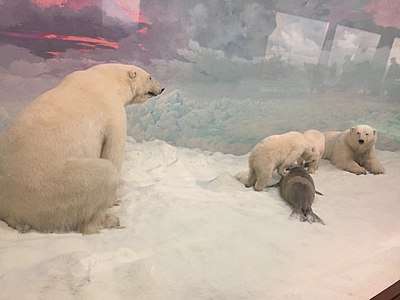 The Museum's famous 1942 Polar bear diorama, featuring a ringed seal
The Museum's famous 1942 Polar bear diorama, featuring a ringed seal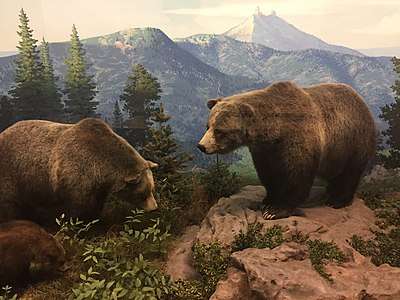 Diorama featuring Grizzly bears at Chimney Rock; Grizzlies have not been extant in Colorado since 1979
Diorama featuring Grizzly bears at Chimney Rock; Grizzlies have not been extant in Colorado since 1979.jpg) Plains Zebras and a Steenbok in a diorama from the 'Botswana' exhibit
Plains Zebras and a Steenbok in a diorama from the 'Botswana' exhibit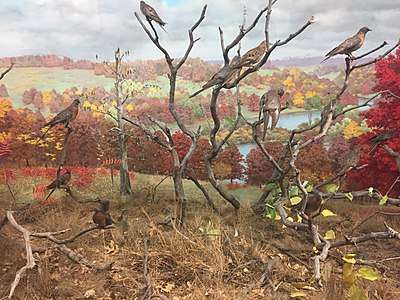 Passenger Pigeons from Johnson County, Iowa in this 1890s scene in a diorama featuring the now extinct bird
Passenger Pigeons from Johnson County, Iowa in this 1890s scene in a diorama featuring the now extinct bird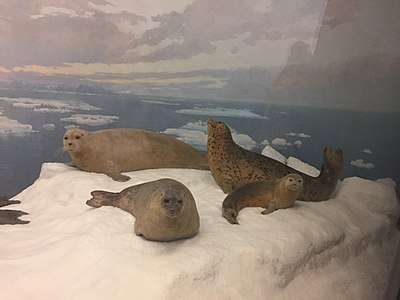 A Bearded seal, a Ringed seal, and two Spotted seals from a portion of a diorama from the Bering Strait near the Diomede Islands
A Bearded seal, a Ringed seal, and two Spotted seals from a portion of a diorama from the Bering Strait near the Diomede Islands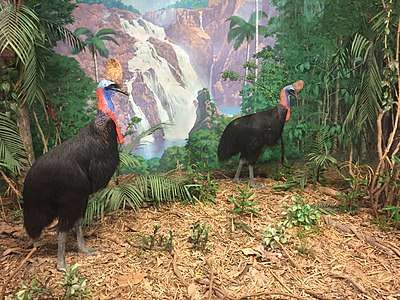 A diorama featuring two southern cassowaries
A diorama featuring two southern cassowaries Comparison of skulls from a normal Grizzly bear and its Alaska subspecies
Comparison of skulls from a normal Grizzly bear and its Alaska subspecies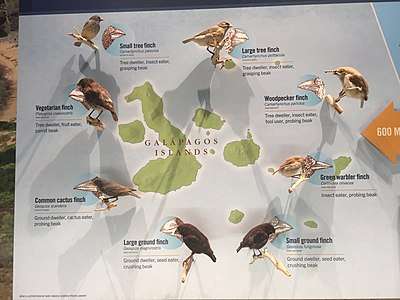 Display of assorted Darwin's finches
Display of assorted Darwin's finches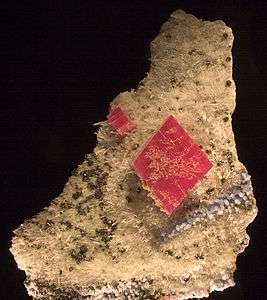 The "Alma King", the world's largest rhodochrosite crystal
The "Alma King", the world's largest rhodochrosite crystal Diorama from the 'North American Indian Cultures' exhibit, depicting a group of Cheyenne Indians in the 1860s near modern-day Denver
Diorama from the 'North American Indian Cultures' exhibit, depicting a group of Cheyenne Indians in the 1860s near modern-day Denver Dinosaur sculpture next to the Museum's parking structure
Dinosaur sculpture next to the Museum's parking structure
See also
- List of landmarks of Denver
- List of museums in Colorado
- Making North America (film) – features V.P. Kirk Johnson
References
- "TEA-AECOM 2016 Theme Index and Museum Index: The Global Attractions Attendance Report" (PDF). Themed Entertainment Association. pp. 68–73. Retrieved March 23, 2018.
- "List of Accredited Museums" (PDF). aam-us.org. American Alliance of Museums. Archived from the original (PDF) on January 17, 2013. Retrieved April 6, 2013.
- "Carter's Life Work". Grit-Advocate. Colorado Historic Newspapers Collection. February 16, 1900. Retrieved August 13, 2016.
- "Fairplay Flume, 1892". Fairplay Flume. Colorado Historic Newspapers Collection. June 2, 1892. Retrieved August 13, 2016.
- "Dedication of state museum". Routt County Republican. Colorado Historic Newspapers Collection. July 10, 1908. Retrieved August 13, 2016.
- "New evidence links America and ancients". Schenectady Gazette. August 28, 1936.
- Noel, Tom (May 7, 2005). "Museum Naturally Evolved Since 1900". Rocky Mountain News. Archived from the original on November 18, 2018. Retrieved May 10, 2017.
- Chronis, Peter G. (May 9, 2000). "Natural History now Nature and Science". The Denver Post. Retrieved May 11, 2017.
- "SCFD and the Museum". dmns.org. Denver Museum of Nature and Science. Retrieved August 11, 2010.
- YESENIA ROBLES (February 1, 2010). "Denver Museum of Nature & Science gets largest donation ever". The Denver Post. Retrieved August 15, 2016.
... The Denver Museum of Nature and Science has received an $8 million gift, the largest donation in its 109-year history ...
- Bill Rice (April 28, 1996). "Denver museum exhibit explores Earth's history". The Daily Gazette. Retrieved August 13, 2016.
- Mary Rodriguez (April 19, 2016). "DMNS Egyptian mummies undergo high-tech tests in Colorado". 9news.com. Retrieved August 13, 2016.
- "Mummies Undergo CT Scans To Better Understand History « CBS Denver". Denver.cbslocal.com. April 19, 2016. Retrieved August 13, 2016.
- "Annual report for 1961 of the Denver Museum of Natural History, showing screenshots of the Western Brazil diorama on pages 12-14, and almost the full diorama on page 16" (PDF). 1961. Retrieved January 6, 2020.
- "A Spaced Odyssey". westword.com. September 19, 2002. Retrieved January 6, 2020.
- Carol W. Maybach (November 19, 2014). "The Amazing Science Behind Your Personal Tastes: Learning Through Beer and Chocolate". 5280.com. Archived from the original on August 25, 2016. Retrieved August 13, 2016.
- Arctos
- ORNIS
- MANiS
- VertNet
- GBIF
- GenBank
- BISON
- Bailey Library and Archives
- Terri Cook (January 19, 2016). "Denver Museum of Nature and Science Ancient Denvers Explores Geologic History". 5280.com. Archived from the original on August 6, 2016. Retrieved August 13, 2016.
- Electa Draper (February 5, 2014). "Denver Museum of Nature & Science enters new wing and era – The Denver Post". The Denver Post. Retrieved August 13, 2016.
- Joshua Pilkington (May 14, 2014). "Maya: Hidden Worlds Revealed". Lavozcolorado.com. Retrieved August 13, 2016.
- John Wenzel (October 8, 2014). ""Whales" exhibit at Denver Museum of Nature & Science makes a splash – The Denver Post". The Denver Post. Retrieved August 13, 2016.
- Ed Sealover (January 5, 2015). "Silk Road exhibit represents new direction of Denver Museum of Nature & Science (Slideshow) - Denver Business Journal". The Business Journals. Retrieved August 13, 2016.
- "'Silk Road' Exhibit Takes Visitors On Ancient Trade Route « CBS Denver". Denver.cbslocal.com. November 23, 2014. Retrieved August 13, 2016.
- "Denver Museum of Nature and Science Unveils Initiative to Become Rocky Mountain's Premier Resource". PR Newswire. September 21, 2000. Retrieved August 13, 2016.
- Ray Mark Rinaldi (February 20, 2014). "Denver Museum of Nature & Science addition gets the science, misses the nature – The Denver Post". The Denver Post. Retrieved August 13, 2016.
- Sam Brasch (June 9, 2016). "What's Beneath The Denver Museum Of Nature & Science? A Million Dead Animals". Cpr.org. Retrieved August 13, 2016.
- Kristin Hugo (August 9, 2016). "Everything You Were Afraid to Ask About Roadkill". National Geographic. Retrieved August 13, 2016.
- "Denver Museum of Nature and Science Scavenger Hunts"
- Elves at Denver Museum of Nature and Science
- Surprises at Denver Museum of Nature and Science PDF description and location of Museum Secrets
External links
| Wikimedia Commons has media related to Denver Museum of Nature and Science. |
